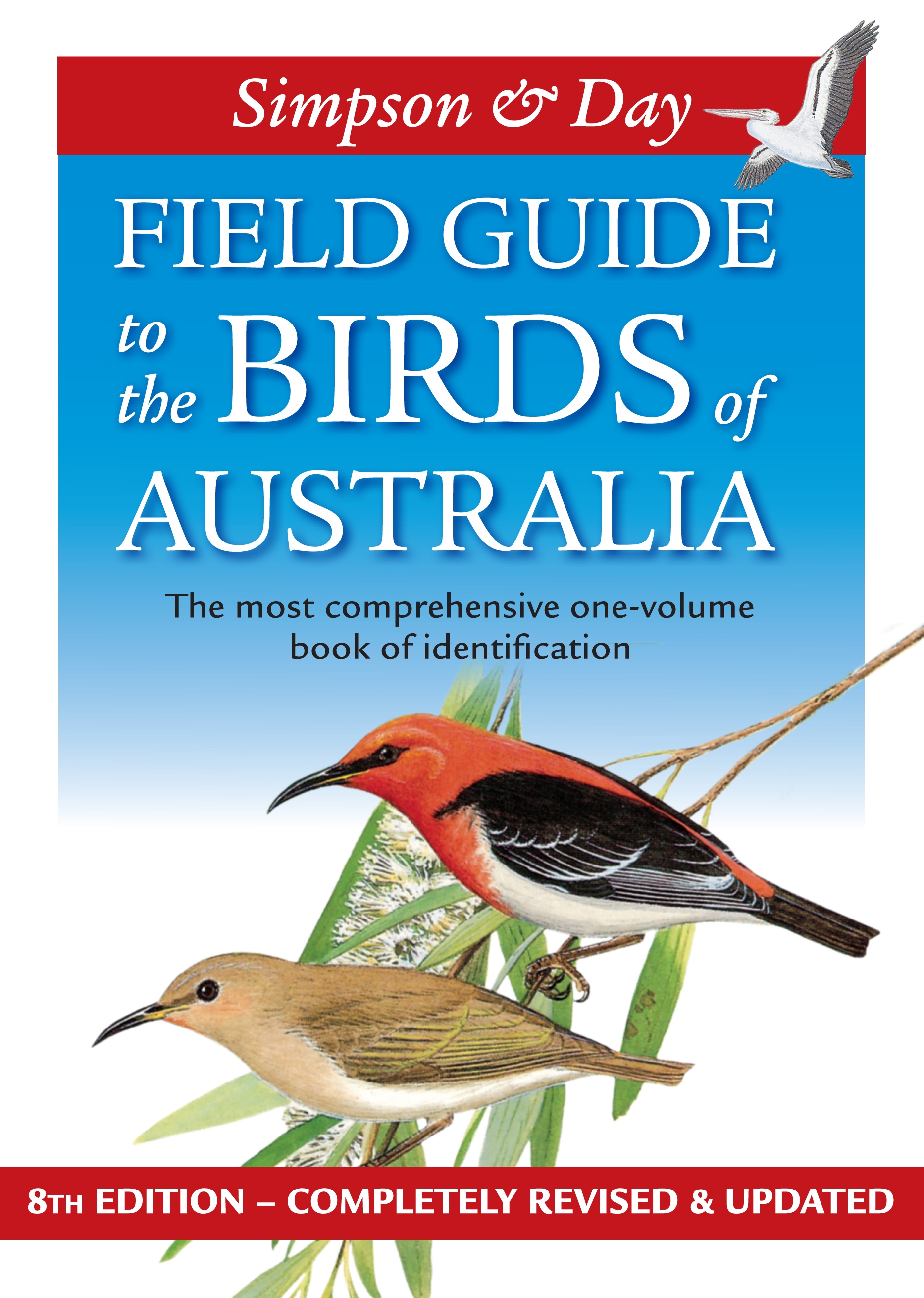
Field Guide to the birds of Australia 8th edition
Everyone interested in birds needs at least one field guide to help with the identification of the birds being seen.
I have several. Ten, in fact. Six of them are Australian field guides, plus I have one covering the birds of South East Asia, one of the Indian sub-continent and two for the British Isles and Europe.
Now I have another one! This field guide is being published TODAY.
Field Guide to the birds of Australia 8th edition
by Ken Simpson and Nicolas Day
(with Peter Trusler)
Ease of use
Many years ago I was given the first edition of this very popular field guide. It has remained largely on my bookshelf in my office, referred to from time to time but never taken out into the field. This was because of its bulky size and being in hardback couldn’t really be called a “field guide” as it was too big to carry around. Recent editions have been far more portable, and this new edition is excellent: convenient size, portable, and at 826 grams just the right weight.
Features:
There are many fine features in this edition. There are so many I can only highlight those I think are worth mentioning.
Colour plates:
There are 132 full page colour plates throughout which illustrate every bird found in Australia. The publisher’s use of the word “comprehensive” on the cover is no idle boast. Each colour plate shows about five or six different species, most shown in typical poses to help identification. Birds most often seen in flight, such as eagles and sea birds like terns, are also shown in flight. The colour rendition of each species appears very good in most cases, especially those I am very familiar with. One page I’d take exception to is the plate showing White-eyes and Silvereyes, as the birds I’ve seen in this group have far more vibrant colours. The ‘red’ robins suffer the same fate, along with some of the fairy-wrens. On the other hand, the rendition of the cuckoos, parrots doves and pigeons are very colourful and well done. The birds of prey (owls, hawks, eagles and kites) are brilliant.
Text pages:
Opposite each colour plate where the birds are illustrated is the text page. Each species has a short description of the bird, including sexual and race variations. The text also includes details of size, juvenile plumage, voice and preferred habitats. Breeding information is included in a separate section. The text is the part of this guide of which I am most critical. For my needs it is too short, too concise. In many cases I will need to go elsewhere in my library to find the information I need. For the casual bird watcher it is quite adequate. I concede that to expand this section to please me would probably add 20-30% more pages to the volume making it less portable in the field. The authors must have had some tough decisions to make along the way.
Next to the text they have included some 900 black and white sketches showing identification features hard to include in the text. This is an excellent feature. The text section is complete with a small map showing normal breeding and non-breeding distribution. Another excellent feature of the maps is to delineate the range of each race of the species, along with extra notes on some species where deemed necessary.
Breeding information:
A separate section details comprehensive breeding information. This includes a brief description of the nest, number and colour of eggs, incubation periods and what the hatchlings look like. It includes fledging periods and some notes about the care of the young until independence. Each species also has a bar graph showing typical breeding seasons.
Vagrant Species:
Special note must be made about the 21 pages of vagrant species included at the end of the colour plates. These pages show sightings of species not normally present in Australia (ie vagrants) but which have been officially accepted on to the Australian list of birds. Some have only been seen the once, others on only a handful of occasions.
Other features: these are too many to review here. All I can do is add a list:
- A water resistant cover – useful on wet days in the field.
- Help for beginners on how to observe a bird.
- Where birds live – a useful, informative section on variations in habitats.
- Australian island territories checklists
- Hints for birdwatchers
- An extensive glossary of words used by birders.
- A list of bird-watching organisations.
- Core library – an extensive list of publications the authors suggest for keen birders to build up their own reference library.
Conclusion:
We are so blessed here in Australia with so many excellent birding field guides. Each has strengths and weaknesses, so the choice of which to buy becomes an agonising one. I have no hesitation in recommending this new edition because of the comprehensive coverage of Australian birds in a compact, easy to use volume. An truly incredible amount of information has been packed into its 381 pages. The publisher claims to have sold over 500,000 copies in earlier editions. This new, completely revised 8th edition will continue that trend and sell many more copies in the future.
While I would like more information in the text this is just a personal need; not everyone needs the detail I require. For the vast majority of people with a passing interest in our birds, this is an ideal guide to have on the bookshelf or in the car or rucksack when travelling. At a RRP of $39.95 it is also very affordable.
Disclosure: The publicist of Penguin Books Australia kindly sent me a review copy a few weeks ago. Thanks Leisel.
References:

A page from the field guide






